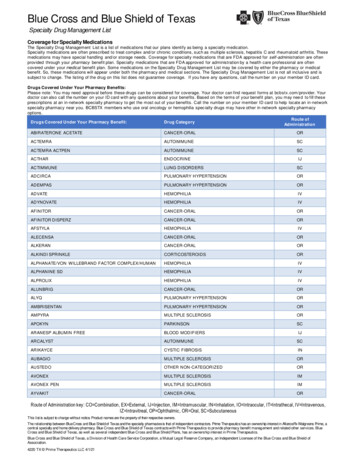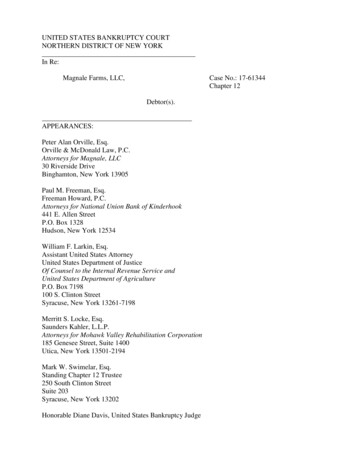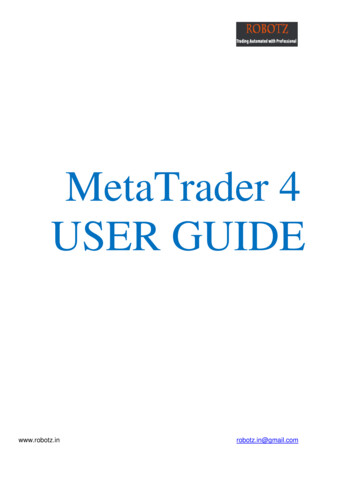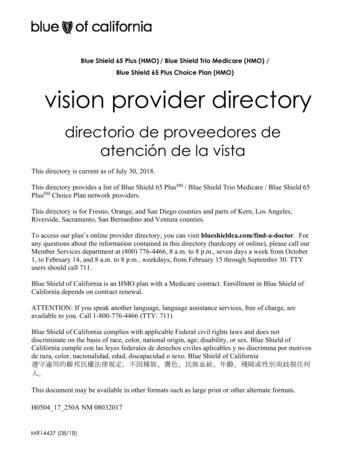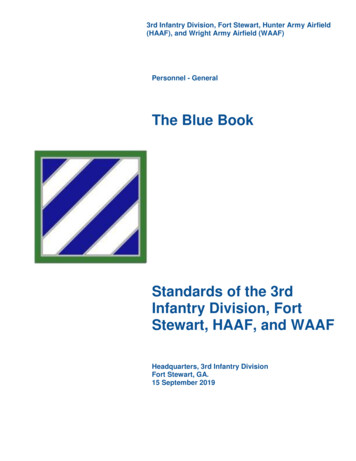
Transcription
3rd Infantry Division, Fort Stewart, Hunter Army Airfield(HAAF), and Wright Army Airfield (WAAF)Personnel - GeneralThe Blue BookStandards of the 3rdInfantry Division, FortStewart, HAAF, and WAAFHeadquarters, 3rd Infantry DivisionFort Stewart, GA.15 September 2019
THE BLUE BOOKMARNE STANDARDSSECTION ONE . 51.2.3.4.5.6.7.COMMANDING GENERAL’ S INTENT . 5P URPOSE . . 6A PPLICABILITY . . 6R ESPONSIBILITIES . . 6VISION STATEMENT . . 6GENERAL . . 63 RD I NFANTRY D IVISION MISSION AND VISION. . 6SECTION TWO . 71.2.3.4.5.P ERSONAL A PPEARANCE P OLICIES . . 7UTILITY UNIFORMS (A RMY COMBAT UNIFORM, ACU). . 10T HE MARNE STANDARD. . 15P HYSICAL FITNESS . 18OFF -DUTY APPEARANCE . . 21SECTION THREE . 221.2.3.4.5.F ORT STEWART/ HAAF CONDUCT . . 22“OFF -LIMITS ” STRUCTURES AND AREAS . . 24MILITARY COURTESY, AR 600-25. . 24BARRACKS AND HOUSING . . 26SPONSORSHIP . . 29SECTION FOUR . 291.1.2.3.SAFETY AND PROTECTING THE FORCE . . 29SAFETY I NSPECTIONS, BRIEFINGS AND DISCUSSIONS. . 34SEXUAL H ARASSMENT/A SSAULT RESPONSE & P REVENTION (SHARP). . 34MEDIA T IPS. . 36SECTION FIVE . 381.REFERENCES. . 38SECTION SIX . 39THE DIVISION PATCH . 39MEDAL OF HONOR . 39DECORATIONS . 393 RD INFANTRY DIVISION HISTORY . 40WORLD WAR I . 403
THE BLUE BOOKMARNE STANDARDSWORLD WAR II . 40KOREAN WAR AND THE COLD WAR . 41GERMANY . 42F ORT STEWART . 42I RAQ – OIF AND OND . 42MARNE HEROES, PAST & RECENT . 44SECTION SEVEN . 47THE MARNE SONG. 47SECTION EIGHT . 481.HISTORY OF “ROCKY THE BULLDOG” . 484
THE BLUE BOOKMARNE STANDARDS2. Purpose.This Blue Book will inform Soldiers, Noncommissioned Officers, and Officers of theMarne Division, Fort Stewart, Hunter Army Airfield, and Wright Army Airfield aboutexpectations for individual discipline, appearance, conduct, and military courtesy asestablished by Army Regulations and policies.3. Applicability.This Blue Book applies to all United States Servicemembers assigned to Fort Stewart,Hunter Army Airfield, and Wright Army Airfield. 3rd Infantry Division Soldiers who resideon other installations will comply with the host installation standards and policies, shouldpolicies conflict. Although not intended as a punitive document, this Blue Book containsprovisions from Army Regulations, such AR 670-1, that are punitive and will be enforcedaccordingly.4. Responsibilities.Commanders and leaders are held responsible to ensure Soldiers present a professionalappearance and conduct themselves as such both on and off duty. Soldiers will takepride in their appearance and conduct themselves properly at all times. Leaders arerequired to read and understand this pamphlet, brief their Soldiers, and enforce thesestandards. Leaders at all levels will ensure all Soldiers have access to the MarneStandards. All Soldiers will have access to the Marne Standards. Soldiers will downloadand carry a digital copy on their smart phones or carry a printed hard copy, both areacceptable.5. Vision Statement.The combat proven 3rd Infantry Division is poised to fight and win our Nation's Wars. Weare quiet professionals who lead by example. We are proud of who we are, our legacy ofservice and sacrifice, our Families, and the communities in which we live and serve. Weare in excellent physical, mental, emotional, social, and spiritual condition. and so areour Families. We are prepared to dominate the next challenge and accomplish allassigned missions, regardless of the hardships involved.6. General.Every Soldier will have access to the Marne Standards. Live the Army Values. Treat otherswith dignity and respect. Do not tolerate or engage in sexual, racial, or other types ofdiscrimination or harassment. Be technically and tactically proficient. Seek to become anexpert in your MOS or Branch and assigned duty position. While absolute uniformity cannotbe expected, personnel must project a military image that leaves no doubt that they live by acommon standard and are responsible for military order and discipline. Only uniforms,accessories, and insignias prescribed by AR 670-1, as approved by Headquarters,Department of the Army, or contained in current authorization documents are worn by U.S.Army personnel. No item governed by the Regulation is altered in any way that changes thedesign or intent of the item. There is NO garrison or field standard, just the Army standard.7. 3rd Infantry Division Mission and Vision.a. 3rd Infantry Division Mission.The 3rd Infantry Division must prepare for worldwide operations in support of Army and CombatantCommand missions in all theaters.6
THE BLUE BOOKMARNE STANDARDSb. 3rd Infantry Division Commanding General’s Enduring Priorities.i. Personnel Readiness. Every Dogface Soldier must be ready to defeat the enemy and winthe fight at first contact. That means we must be competent in our basic skills as Soldiers andexperts in our MOS. This requires the discipline to ensure we are fit and resilient.ii. Sustainment. Maintenance, logistics, and sustainment form the core of our ability to deploy,fight, and win. We cannot survive on the battlefield without planning and resourcing oursustainment. 10/20 is our maintenance standard. This is a commander’s responsibility at everyechelon. Put on your coveralls, as I expect leaders are present in the motorpools conductingmaintenance to standard. It is my responsibility to resource your maintenance operations(funding, parts and time) to meet 10/20 standards.iii. Training. The foundation of our training is the basic combat skills every Soldier needs tosurvive and win in combat. Our NCOs are the primary trainers of our individual skills for everySoldier in our formations to include our officers. If we cannot fight at the platoon level wecannot win as the Army’s premier Division. The 3rd Infantry Division will prioritize resourcesand efforts that focus on lethal platoons and trained companies, troops and batteries. It is myresponsibility to set the conditions for your units to meet these standards.iv. Our Community. Our community starts with our people: the Soldiers, Families and DACivilians who serve in our great Division and in the greater Fort Stewart, Fort Benning andHunter AAF communities. From our gate guards; to our schools’ teachers and CDC caregivers; to artillery, tank and Bradley crews; and across our garrisons and from platoon toDivision HQs, everyone in our community deserves to be treated with dignity and respect. Weall deserve to have a community that we are proud to be a part of. Working with our greatGarrison, local and state officials, it is my responsibility to set the climate and conditions for ourcommunity.v. Setting Conditions for the Future. Our Army is at an inflection point as we continue tobuild readiness to fight in Large Scale Ground Combat Operations (LSGCO). An integral partof building that readiness is modernization and our ability to rapidly deploy across the world.Starting in FY21, the 3rd Infantry Division will begin to modernize our formations making us themost modernized and lethal Division in the Army. We must begin setting those conditions now.vi. Endstate. 3rd Infantry Division units are trained and ready to deploy, fight, and win at firstcontact. We provide combat ready forces to Combatant Commands (COCOM) that are trained,equipped, manned, and maintained to meet mission requirements. Our Soldiers and familiesare integrated into a supportive community that has pride in being the home of the MarneDivision.SECTION TWO1. Personal Appearance Policies.a. General.All Soldiers will abide by AR 670-1 and DA Pam 670-1 at all times. Soldiers willpresent a professional image and will continue to set the example in militarypresence, both on and off duty. Pride in appearance includes physical fitness andadherence to acceptable weight standards in accordance with AR 600 -9.7
THE BLUE BOOKMARNE STANDARDSb. Grooming.Leaders will judge the appropriateness of a particular hairstyle by the guidance in AR670-1, Chapter 3, section 3-2, page 5 and by the ability to wear all types of headgear(such as beret, patrol cap, or service cap/hat) and any protective equipment (such asprotective mask or combat helmet) properly. Hairstyles (including bulk and length ofhair) that do not allow Soldiers to wear any headgear properly, or that interfere withthe proper wear of any protective equipment, are prohibited.i.Male Haircuts. The hair on top of the head must be neatly groomed. The lengthand bulk of the hair may not be excessive and must present a neat andconservative appearance. The hair must present a tapered appearance. (Foradditional guidance see AR 670-1, Para 3-2 (a)ii.Male Sideburns. Sideburns are hair grown in front of the ear and below the pointwhere the top portion of the ear attaches to the head. Sideburns will not extendbelow the bottom of the opening of the ear. Sideburns will not be styled to taper, flair,or come to a point. The length of the individual hairs of the sideburn will not exceed1/8 inch when fully extended.iii.Male Facial Hair. Males will keep their face clean-shaven when in uniform or incivilian clothes on duty. Mustaches are permitted. If worn, males will keepmustaches neatly trimmed, tapered, and tidy. (See AR 670-1, Para 3-1 (b), for fullguidance). Soldiers with shaving profiles will maintain a copy of the prescribedDA Form 3349 at all times. Facial hair will be trimmed to the level specified bythe appropriate medical authority. However, Soldiers are not authorized toshape the growth into goatees, "Fu Manchu," or handlebar mustaches. Ifappropriate medical authority prescribes beard growth, the length required formedical treatment must be specified. For example, "The length of the beardwill not exceed 1/4 in.” (See TB MED 287)iv.Female Hairstyles. May not be eccentric or faddish and will present a conservative,professional appearance.v.Female Short Hair. This is defined as hair length that extends no more than 1 inchfrom the scalp (excluding bangs). Hair may be no shorter than ¼ inch from the scalp(unless due to medical injury) but may be evenly tapered to the scalp within 2 inchesof the hairline edges. Bangs, if worn, may not fall below the eyebrows, may notinterfere with the wear of headgear, must lie neatly against the head, and may not bevisible underneath the front of the headgear. The width of the bangs may extend tothe hairline at the temple.vi.Female Medium Hair. When worn loose, graduated hair styles are acceptable, butthe length, as measured from the end of the total hair length to the base of the collar,may not exceed 1 inch difference in length, from the front to the back.vii. Female Long Length. Long hair is defined as hair length that extends beyond thelower edge of the collar. Long hair will be neatly and inconspicuously fastened or8
THE BLUE BOOKMARNE STANDARDSpinned above the lower edge of the collar, except that bangs may be worn. Noportion of the bulk of the hair, as measured from the scalp as styled, will exceed 2inches (except a bun, which is worn on the back of the head and may extend amaximum of 3 1/2 inches from the scalp and be no wider than the width of the head).viii. Pony Tail. A single pony tail centered on the back of the head is authorized inphysical fitness uniforms and utility uniform only when within the scope of physicaltraining. If physical training is not conducted or, if the helmet is worn during physicaltraining, the hair must be secured or worn up.ix.Cosmetics. Standards regarding cosmetics are necessary to maintain uniformity andto avoid an extreme or unprofessional appearance. Males are prohibited fromwearing cosmetics, except when medically prescribed. Females are authorized towear cosmetics with all uniforms, provided they are applied modestly andconservatively, and that they complement both the Soldier’s complexion and theuniform. Leaders at all levels must exercise good judgment when interpreting andenforcing this policy.x.Eccentric, Exaggerated, or Faddish Cosmetic Styles and Colors. Makeupdesigned to cover tattoos is inappropriate with the uniform and is prohibited.Permanent makeup, such as eyebrow or eyeliner, is authorized as long as themakeup conforms to the standards outlined above. Eyelash extensions are notauthorized unless medically prescribed.xi.Lipstick. Females will not wear shades of lipstick that distinctly contrast with thenatural color of their lips, that detract from the uniform, or that are faddish, eccentric,or exaggerated.xii. Finger Nails. All personnel will keep fingernails clean and neatly trimmed. Males willkeep nails trimmed so as not to extend beyond the fingertip unless medically required andare not authorized to wear nail polish. Females will not exceed a nail length of ¼ inch asmeasured from the tip of the finger. Females will trim nails shorter if the commanderdetermines that the longer length detracts from a professional appearance, presents asafety concern, or interferes with the performance of duties. Females may only wear clearpolish when in uniform or while in civilian clothes on duty. Females may wear clear acrylicnails, provided they have a natural appearance and conform to Army standards.c. Electronic Devices. Cell Phones and Devices.Except in emergency circumstances, Soldiers WILL NOT walk and talk, or walk andtext, while in uniform. This applies to the use of a hands-free device or when the cellphone is in speaker mode. Soldiers may use headphones, including wireless or nonwireless devices and earpieces, in uniform only while performing individual physicaltraining in indoor gyms or fitness centers. Ear pads will not exceed 1-1/2 inches indiameter at the widest point. They may also wear a solid black armband for electronicdevices in the gym or fitness center. Soldiers may not wear headphones or arm bands beyond or outside the fitness center while in uniform. Additionally, musicplaying from media devices, speakers, or other means is not authorized whileperforming physical fitness in uniform.9
THE BLUE BOOKMARNE STANDARDSd. Hearing Protection.All Soldiers will carry issued hearing protection when in military Uniform. All Soldiersare required to wear fitted non-linear hearing protection in all militarytraining/operations involving high-frequency impulse noise that can cause injury toSoldiers’ hearing. Soldiers working in high intensity noise areas or operating enginepowered equipment will wear Army Approved Hearing Protection based on their workrelated protection needs (intensity and duration levels) and individual hearing status.All Army approved hearing protection devices are authorized for use and wear withthe field uniform.e. Eyewear.Conservative civilian prescription eyeglasses are authorized for wear with alluniforms. Conservative prescription and nonprescription sunglasses are authorizedfor wear when in a garrison environment. Soldiers are authorized to wear ballisticspectacle eye protection issued by the Army to include Smoke/T inted/Clear lenses aslong as they are part of the Authorized Protective Eyewear List (APEL) visit PEOSoldier for the entire Qualified Products List atwww.peosoldier.army.mil/eguipment/eyewear/. Contact lenses that change thenatural color of the eyes are prohibited while in the duty uniform. Contact lenses arenot authorized in field conditions. Supervisors will ensure Soldiers wear Armyprovided eye protection whenever necessary to protect against chemical,environmental, radiological, or mechanical irritants and hazards to eyesight. AllPersonal Protection Equipment (PPE) will be checked for serviceability and replacedas necessary to maintain its respective protective characteristics .2. Utility Uniforms (Army Combat Uniform (ACU)).a. General.All military uniforms will be worn IAW AR 670-1. Commanders have the ability to tailor theuniform based on seasonal weather conditions or tactical requirements. If worn off post,utility uniforms will be clean and serviceable. Soldiers will not wear utility uniforms (ClassC) off-post in any establishment which primarily serves alcohol. Under no circumstanceswill a Soldier consume alcohol off-post while in Class C uniform. Personnel on officialtravel will wear the service uniform or appropriate civilian attire.10
THE BLUE BOOKMARNE STANDARDSFigure 1 Army Combat Uniform, Operational CamouflagePattern (OCP).b. ACU in the Operational Camouflage Pattern (OCP).i.ACU Coat. The coat will not extend below the top of the cargo pocket on thetrousers and will not be higher than the bottom of the opening of the side pocket onthe trousers. Sleeves will be worn down at all times and may be cuffed only duringfield exercises (see Figure 4). The T-shirt is never worn as an outer garment exceptduring personal hygiene, sleeping, or working out inside the gym.ii.ACU Trousers. When bloused the trousers should not extend below the third eyeletfrom the top of the boots.iii.ACU Sleeves Roll. Commanders may authorize Soldiers to roll-up the sleeveson the ACU. Company level Commanders will request through the BattalionCommand for approval to change the uniform. Company level Commanders willthen determine if the unit will roll sleeves with the camouflage pattern exposed orturned inside out. Personnel will roll sleeves neatly above the elbow but no morethan 3 inches above the elbow. Upon approval of the commander and only duringfield training exercises, the sleeves may be down and cuffed inside the coat oneor two times.11
THE BLUE BOOKMARNE STANDARDSFigure 2 Rolled Sleeves authorized by thecommander.Figure 3 Sleeves down and cuffed,authorized by the commander onlyin the field.Figure 4 Sleeves down and cuffed.c. Flight Suit.The Army Aviation Combat Uniform (A2CU) is worn on duty when flying, on standbyawaiting flight, or as directed by the commander. A2CUs are not authorized foreveryday wear in garrison or office environments.i.The 100 percent cotton or flame-resistant material brown T-shirt is the onlyauthorized T-shirt for wear with the A2CU. Long-sleeved white thermal shirts areauthorized to be worn under a brown shirt. Sleeves will not be pushed or rolled.ii.All Army combat boots authorized to be worn with the A2CU must be coyote incolor and must be IAW the United States Army Aeromedical ResearchLaboratory specification and guidelines for hot weather-flame resistant andIntermediate Cold Weather Boot with removable liner.iii.Personnel wearing the A2CU outside of the flight line will blouse the trousers.When bloused, the trousers should not extend below the third eyelet from the topof the boot. Unit logo patches are not authorized to be sewn or hook and loopfastened on the uniform.12
THE BLUE BOOKiv.MARNE STANDARDSThe flame-resistant Army Combat Shirt (ACS) is authorized for aircrew members.It is only to be worn when engaged in flight duties with the A2CU trousers andunder the Interceptor Body Armor (IBA) ensemble.d. ACS.The ACS is authorized only during field training or in a combat zone, and must beworn with name tape, unit patch, and US Flag. The combat shirt is not authorize d forwear in any facility (PX, Shoppette, Burger King, etc.) on post or in any off-postestablishment .e. Headgear.Soldiers in uniform will wear appropriate headgear when outdoors except when itinterferes with safety. When headgear is stored, it will not create a bulky appearanceor protrude from any pocket.i.The Patrol Cap will be worn straight on the head so that the cap band creates astraight line around the head, parallel to the ground. No rolling of, blocking, oralterations to the cap are authorized. The cap is worn so that no hair is visible onthe forehead beneath the cap.Figure 5 Patrol Cap front view.Figure 6 Patrol Cap side view.ii.The Beret will be worn with the Army Service Uniform (ASU) and utility uniformduring ceremonies or special duties as required by the commander. The beret isworn with the ASU, Class A, Class B and Class C uniforms with the edge binding1 inch above the eyebrow and straight across the forehead. Center the flashabove the left eye. Pull the excess material between the top and middle of theright ear. Hair should not extend below the front bottom edge of the beret.Officers wear their rank centered on the flash while enlisted wear their distinctiveunit insignia on the flash.iii.The Black Fleece Cap might be worn with ACU in Garrison, field, flight line, or on13
THE BLUE BOOKMARNE STANDARDSstatic guard duty when the ambient temperature, to include wind chill, reaches30 degrees or when designated by the Chain of Command. Soldiers will wearthe fleece cap, pulled down snugly on the head. The bottom edge (a portion of orall) of the cap may be folded, but not rolled.iv.Neck Gaiter is authorized and may be worn with the APFU, and tactical uniformswhen temperatures reach 30º F and below or when designated by the Chain ofCommand. It may be worn as a neck warmer, hood, or balaclava/mask. Neck gaiterswill be removed when indoors.f. Cavalry Spurs and Stetson.These items will be worn only in the unit’s immediate area or for special functionssuch as: unit dining-ins/outs, formal events, professional gatherings, and other eventsdesignated by the Squadron Commander. Under no circumstances they will be wornin the PX, Shoppette or similar facilities.i.The Stetson will be black in color. At a minimum, a braided cord, rank andregimental or ordinary cavalry brass will adorn the Stetson. The nape strap willbe threaded through the appropriate eyelets in the brim of the Stetson, so thatthe strap goes around the back, and the buckle is fastened an d centered on thewearers head. The sides of the crown will not be pushed in or otherwisemodified. The brim will be flat with a slight droop at the front. The Stetson will beworn on the head with the brim parallel to the ground.ii.Spurs may be worn whenever the Stetson is authorized. Gold spurs areauthorized for Soldiers who have served in combat in a Cavalry unit. Silver Spursare authorized for Soldiers who earn them IAW Cavalry Squadron policy.g. Army Combat Boots.i.Soldiers are required to possess two pairs of issue Army combat boots (HW) andone pair of issue Army combat boots (temperate weather) (specification) boots.(For additional guidance, see (DA Pam 670-1, Para 18-4)ii.Commercially-Sold Boots. (Optional) Soldiers may wear commercial boots of adesign similar to that of the Army combat boot (tan or coyote), as authorized by thecommander. (For additional guidance, see (DA Pam 670-1, Para 18-4)h. Reflective Safety Belt.A reflective belt may be worn during work details or when appropriate for safety (suchas ground guide duties, railhead operations, etc.). Nevertheless, the senior leader onsite will determine its need based on risk assessment.i. Camelback.The use of a black or camouflage pattern personal hydration system (Camelback) isauthorized while conducting Physical Training, field exercises, and work details inhigh temperature.14
THE BLUE BOOKMARNE STANDARDSj. Bags.If Soldiers choose to wear a shoulder bag while in uniform, the bag must be black ormatch the camouflage pattern uniform and have no commercial logos. The contentsof the bag may not be visible. Soldiers may carry authorized bags by hand, on oneshoulder or both. Soldiers may not wear a shoulder bag in such a manner that thestrap is draped diagonally across the body. Any bag that does not meet the abovecriteria must be carried only in the hand.3. The MARNE STANDARD.The Marne Standards are the base standards for all Soldiers operating in the field ortactical environment. Commanders are authorized to modify the Marne Standardsbased on METT-TC, weather, and /or mission.a. The Marne Standards consist of the following:i.Army Combat Uniform.ii.Advanced Combat Helmet (ACH).iii. Authorized Protective Eyewear List (APEL) ballistic protection is wornwhenever the helmet is worn.iv. The Improved Outer Tactical Vest (IOTV), or issued plate carrier with ModularLightweight Load Carrying Equipment System (M.O.L.L.E.) or Ranger AssaultCarrying Kit (RACK). The Outer Tactical Vest (OTV) or RACK is typically usedby combat vehicle crews but can be worn by dismounted personnel IAW unitSOP.v.The Improved First Aid Kit (IFAK) is worn on the lower left side of the IO TV.vi. Enhanced Small Arms Protective Insert (ESAPI).vii. Enhanced Side Ballistic Inserts (ESBI).viii. Hydration System (camelback) or canteens.xiii. Gloves (full fingered).xiv. Individual assigned weapon.b. Additional Items worn with the Marne Standards.xv. Knee pads.xvi. Elbow pads.xvii. Coverall/ Nomex.xviii. Protective mask.15
THE BLUE BOOKMARNE STANDARDSFigure 20 Pro-Mask.Figure 20 Pro-Mask.Figure 7 Marne Standards, IOTV configuration.Figure 8 Marne Standards, Plate carrier configuration.Figure 9 Marne Standards, rear view.Figure 10 Marne Standards, side view.Note 1: No unauthorized patches will be worn on the uniform.16
THE BLUE BOOKMARNE STANDARDSc. Individual Outer Tactical Vest (IOTV).The IOTV / Plate Carrier will be worn closed with all snap, hook and loop fastened,nametape and rank. Leaders will ensure all Soldiers have the Individual First Aid Kit(IFAK) attached to the IOTV or Fighting Load Carrier (FLC)/Tactical Assault Panel (TAP)system for training and combat operations.Figure 12 ESAPI plate for IOTV or Platecarrier.Figure 11 IOTV, front view.d. Ballistic Protection.Many training events do not require ballistic protection (land navigation, footmarches, etc.) but live-fire training, qualification ranges, and collective training eventswith a tactical scenario with opposing force are examples that do. When full ballisticprotection is required, the IOTV or, if issued, Interceptor Body Armor (IBA) or SoldierPlate Carrier System (SPCS) will be worn. During live fire training, deployments orwhen directed, Soldiers will be issued and wear front, back, and sides Small ArmsProtective Insert (SAPI)/Enhanced Small Arms Protective Insert (ESAPI) ballisticplates. Commercial body armor and plate carriers are not authorized for wear. TheIOTV, IBA, and SPCS are the only authorized body armor for training or deploymentunless otherwise issued.e. Advance Combat Helmet (ACH).The ACH will be complete with ACU cover, the 7 pad suspension system, retentionsystem (chinstrap) fastened at all times, camouflage band, and Night-Vision Goggles(NVG) mount.Figure 13 Army Combat Helmet (ACH), frontview.Figure 14 Army Combat Helmet (ACH), rear view.17
THE BLUE BOOKMARNE STANDARDSFigure 16 Army Combat Helmet (ACH), left sideview.Figure 15 Army Combat Helmet (ACH), right side view.4. Physical Fitnessa. General.All 3rd Infantry Division Soldiers will conduct PRT when in garrison Monday throughFriday from 0630-0800. No Soldier conducts physical readiness training alone duringPRT hours. Leaders conduct PRT as a group and with their respective formations .Command teams may conduct PRT as a team or split to cover their formations. Noactivities will interfere with scheduled PRT sessions.b. Gymnasiums and Gyms in a Box.The six event Army Combat Fitness Test (ACFT) requires Soldiers to strengthen muscles,endurance, and mobility through a prescribed training plan and equipment found in ourgyms. Leaders are encouraged to add the gymnasium facilities as part of their PT pl
THE BLUE BOOK MARNE STANDARDS 6 2. Purpose. This Blue Book will inform Soldiers, Noncommissioned Officers, and Officers of the Marne Division, Fort Stewart, Hunter Army Airfield, and Wright Army Airfield about expectations for individual discipline, appearance, conduct, and military cou


